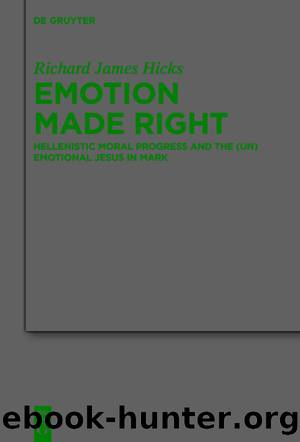Emotion Made Right by Richard James Hicks

Author:Richard James Hicks
Language: eng
Format: epub
Publisher: De Gruyter
Published: 2021-09-20T12:37:58.077000+00:00
4.3
Conclusion
As per Hellenistic emotion theory, Mark characterizes Jesus as an anti-emotional exemplar of soul or lifestyle health who keenly recognizes emotional wounds, including his own, and consistently attempts a rational remedy that incorporates godly reasoning. By proclaiming the gospel or logos of the kingdom of God, Jesus extends mercy to a company of characters who are affectively weakened, in varying degree, by emotional disbelief and its corollary emotions, especially anger and/or fear. These emotions have the potential to destroy the soul (cf. 3:4; 8:35; 14:34). They invariably feature a temptation to reject Jesusâs authority or godly reasoning/logos, and thus parallel satanic opposition to the fruition of Jesusâs gospel (cf. 4:15âââ19; 8:31âââ33). A faithful response to Jesusâs godly reasoning requires a type of anti-emotional repentance from the rising emotion that opposes it.
Jesus also practices his preaching whenever his own soul is emotionally wounded; he endures rising emotional temptation with moralist-approved techniques for utilizing godly reasoning: e.âg., prayer, strategic silence, accountability, and delaying the âfilthyâ provocation(s) for examination. On at least three occasions, Jesus experiences moralist-attested warning signs of rising anger, and in Gethsemane, while awaiting his impending arrest, psychosomatic pain common to rising fear. Whereas the emotional goal of anger is an act of vengeance, fear seeks self-preservation or a hasty escape to a safe space. On the Sabbath, the enemies of healing contribute to Jesusâs synonymous pre-emotional experiences of âpainâ (λύÏη κÏλ) and âround-about lookingâ (ÏεÏιβλέÏÏ) or âangryâ eyes (3:5). Later, when Jesus finally arrives at Jerusalem, an ungodly sight at the temple also provokes angry âround-about lookingâ (ÏεÏιβλέÏÏ). The psychosomatic pain of rising anger further affects Jesusâs breathing and innards when he âcleansesâ a leper (1:41). At Gethsemane, Jesus again experiences pre-emotional âpainâ (λύÏη κÏλ), though here it is synonymous with experiences of anxious âdistressâ (á¼Î´Î·Î¼Î¿Î½á½³Ï) and âshockâ (á¼ÎºÎ¸Î±Î¼Î²á½³Ï) more than anger.
In each of these cases, Jesus successfully endures some degree of emotional temptation to betray or disregard his divinely commissioned purpose to proclaim the gospel. At the Jerusalem temple, for example, Jesus delays rising anger overnight, which ensures that his decision to clear it does not stem from an angry impulse for vengeance, but rather from reasoned reflection on Scripture and a desire to âteachâ about prayer (11:17). In Gethsemane, likewise, Jesus delays his anxious desire to avoid suffering long enough to vanquish it in prayer and then confidently faces his captors, appealing again to the motivating force of godly reasoning or Scripture (14:49). Similarly, despite heated resistance from his critics on the Sabbath, it is his concern for what is right or âlawfulâ on the Sabbath that motivates Jesus to restrain anger and proclaim his anti-emotional logos in healing deed (3:4). Again, honoring Scripture or promoting godly logos is Jesusâs primary motivation for âcasting outâ the leper, not retaliation for the rising anger that pains his innards and labors his breathing.
The religious leaders and disciples are the two most prominent, emotionally affected groups in Mark, and they serve the narrative as foils for Jesusâs most decisive victories over rising emotional temptation.
Download
This site does not store any files on its server. We only index and link to content provided by other sites. Please contact the content providers to delete copyright contents if any and email us, we'll remove relevant links or contents immediately.
Machine Learning at Scale with H2O by Gregory Keys | David Whiting(4104)
Never by Ken Follett(3761)
Fairy Tale by Stephen King(3192)
The Man Who Died Twice by Richard Osman(2977)
Reminders of Him: A Novel by Colleen Hoover(2928)
Will by Will Smith(2769)
Rationality by Steven Pinker(2271)
It Starts With Us (It Ends with Us #2) by Colleen Hoover(2173)
Can't Hurt Me: Master Your Mind and Defy the Odds - Clean Edition by David Goggins(2147)
Friends, Lovers, and the Big Terrible Thing by Matthew Perry(2099)
The Becoming by Nora Roberts(2061)
The Stranger in the Lifeboat by Mitch Albom(2031)
Love on the Brain by Ali Hazelwood(1931)
New Morning Mercies: A Daily Gospel Devotional by Paul David Tripp(1864)
The Strength In Our Scars by Bianca Sparacino(1765)
HBR's 10 Must Reads 2022 by Harvard Business Review(1763)
A Short History of War by Jeremy Black(1743)
Never Finished: Unshackle Your Mind and Win the War Within by David Goggins(1622)
515945210 by Unknown(1582)
